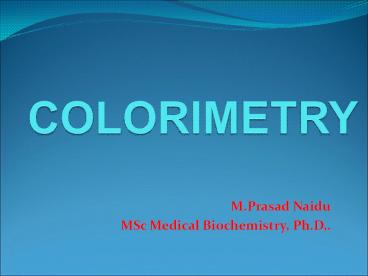Colorimetry - PowerPoint PPT Presentation
Title:
Colorimetry
Description:
Biochemistry – PowerPoint PPT presentation
Number of Views:2617
Title: Colorimetry
1
COLORIMETRY
- M.Prasad Naidu
- MSc Medical Biochemistry, Ph.D,.
2
colorimetry
- It is the most common analytical technique used
in biochemical estimation in clinical laboratory. - It involves the quantitative estimation of color.
- A substance to be estimated colorimetrically,
must be colored or it should be capable of
forming chromogens (colored complexes) through
the addition of reagents.
3
- Colored substance absorb light in relation to
their color intensity. - The color intensity will be proportional to the
conc. Of colored substance. - The instruments used in this method are
colorimeter or photometer or absorptiometers.
4
principle
- Colored solutions have the property of absorbing
certain wavelength of light when a monochromatic
light is passed through them. - The amount of light absorbed or transmitted by a
colored solution is in accordance with two laws - Beers law
- Lamberts law
5
- Beers law
- When a monochromatic light passes through a
colored solution, amount of light transmitted
decreases exponentially with increase in
concentration of colored substance. - i.e. the amount of light absorbed by a colored
solution is directly proportion to the conc. Of
substance in the colored solution.
6
- Lamberts law
- The amount of light transmitted decreases
exponentially with increase in pathlength
(diameter) of the cuvette or thickness of colored
solution through which light passes. - i.e. the amount of light absorbed by a colored
solution depends on pathlength of cuvette or
thickness or dept of the colored solution.
7
- Combined beers- lamberts law is thus expressed
as amount of light transmitted through a colored
solution decreases exponentially with increases
in conc. Of colored solution increase in conc.
of colored solution increase in the pathlength
of cuvette or thickness of the colored solution
8
(No Transcript)
9
Parts of the colorimeter
- Light source tungsten filament lamp
- Slit it is adjustable which allows only a beam
of light to pass through. it prevents unwanted or
stray light - Condensing lenses light after passing through
slit falls on condenser lense which gives a
parllel beam of light.
10
- Filter
- made of colored glass. Filters are used for
selecting light of narrow wavelength. - filters will absorb light of unwanted wavelength
and allow only monochromatic light to pass
through. - For ex a green filter absorbs all color, except
green light which is allowed to pass
through.light transmitted through a grenn filter
has a wavelength from 500-560 nm. - Filter used is always complimentary in color to
the color of solution.
11
(No Transcript)
12
- Cuvette(sample holder) the monochromatic light
from the filter passes through the colored
solution placed in a cuvette. - it is made up of special glass/plastic/quartz
material. - it may be square/rectangular/round shape with
fixed diameter (usually 1 cm) having uniform
surface.the colored solution in the cuvette
absorbs part of light remaining is allowed to
fall on detector. - For ex a solution of red color transmits red
light absorbs the complimentary color green.
13
- Detector (photocell)
- Detector are photosensitive elements which
converts light energy into electrical energy. - The electrical signal generated is directly
proportional to intensity of light falling on the
detector. - Output the electrical signal generated in
photocell is measured by galvanometer, which
displays percent transmission optical density.
14
(No Transcript)
15
- Use of test (T), standard (S) and blank (B)
- In colorimetric estimation , it is necessary to
prepare a blank (B), a standard (S) test (T). - Test this solution is prepared by treating a
specific volume of specimen (blood,urine,
CSFetc) with reagents.
16
- Standard prepared by treating a solution of the
pure substance of unknown conc. With reagents. - Primary standard the same substance is used as
standard one which is to be estimated. - For ex pure glucose is taken as standard in
estimation of blood glucose.
17
- Secondary standard
- Here the substance taken as standard is different
from the substance to be estimated. - This substance taken as standard should match the
color of final product. - For ex methyl red is taken as standardin
estimation of serum bilirubin.
18
- Blank prepared for rule out color produced by
reagents alone. - Two types of blank
- Distilled water as blank
- reagent blank (reagent used in the estimation is
taken as blank)
19
- Calculation
- conc. Of substance in mg /100mg or gm/100ml of
sample. - OD of test- OD of blank conc. of standard
100 - OD of standard vol. of test
sample - OD of blank
20
- Application of colorimetric assay
- Used in determination of amount of many
substances in blood, urine, saliva, CSF other
specimens. - Ex for common colorimetric assay are
determination of blood glucose, blood urea, serum
creatinine, serum proteins, serum cholesterol,
serum inorganic phosphate, urine creatinine
glucose in CSF, etc.
21
THANK YOU

